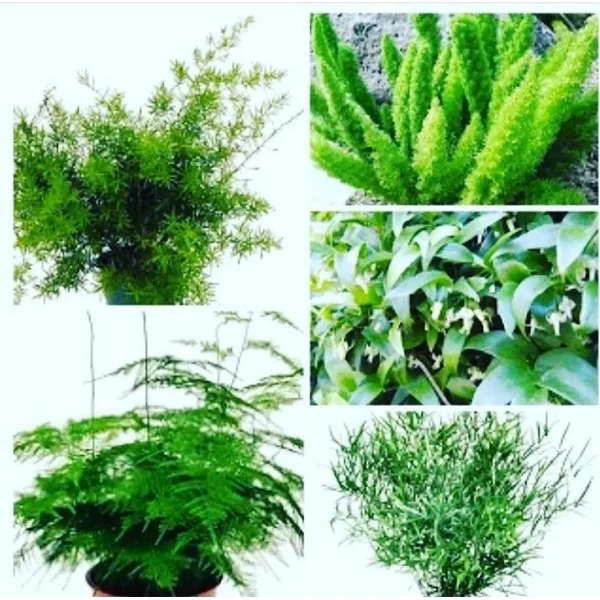5 Different Types of Asparagus Ferns for Indoors with Pictures and Care Guides
Some links in this post may be affiliate links
Asparagus Ferns are popular plants on account of their beauty and ease of care as they easily adapt to wide variations in light, heat and frequency of watering.
Some of these ferns have needle-like "leaves" which give them a ferny appearance, hence the common name, fern. Though they have the name 'fern' as part of their common name, they are not True Ferns, Asparagus Ferns are much easier to grow than true ferns.

Asparagus Ferns are toxic to humans and pets as indicated by ASPCA. If the berries are ingested, they can cause vomiting, diarrhea and abdominal pain. If handled with bare hands, the berries can cause contact dermatitis.
In addition, the foliage of mature plants can develop sharp spines on the branches which can cause skin irritation if handled with bare hands. Therefore, always wear gloves when handling these plants.
As outlined by Mark Tancig (University of Florida), Asparagus Ferns have been found to be invasive in some regions. Therefore, avoid growing Asparagus Ferns in the ground and dispose them by burning as they grow vigorously, spreading across and scrambling up other plants.
Nonetheless, if you are looking to add Asparagus Ferns to your collection, we have outlined for you herebelow 5 popular Asparagus Ferns that you can easily grow in your home.
5 Popular Ornamental Asparagus Ferns for Indoors
Popular Asparagus Ferns are Asparagus plumosus, Asparagus densiflorus 'Sprengeri', Asparagus densiflorus 'Meyeri', Asparagus falcatus and Asparagus asparagoides. Keep reading for more on these magnificent Ornamental Asparagus Ferns.
1. Asparagus plumosus (Asparagus Fern)

Asparagus plumosus commonly called Asparagus Fern, Asparagus Grass, Lace Fern, Climbing Asparagus or Ferny Asparagus is grown for the gracefully, drooping, feathery foliage which is often used in floral arrangements.
Ferny Asparagus bears thick, tuberous roots which store water and enable the plant to go for a considerably long period without being watered. These characteristics place it among the best drought-tolerant plants that you may grow in any space.
Asparagus plumosus flourishes in medium to bright indirect light, warmth of 16-280C, humidity of 50-55% and moderately moist, fertile, well-drained potting soils coupled with weekly feeding during the growing season.
Learn more on how to grow and care for Asparagus Fern
2. Emerald Fern (Asparagus densiflorus 'Sprengeri')

Emerald Fern also called Sprenger's Asparagus is an evergreen fern-like plant whose arching, trailing stems are sparsely covered with clusters of soft, needle-like, bright-green 'leaves' hence the common name 'Emerald Fern'.
Sprenger's Asparagus is ideal for a hanging basket, tabletop, desktop or pedestal where the stems can cascade downwards beautifully. It can also be grown as an outdoor container plant. Emerald Fern is one of the best plants for the office space.
Asparagus densiflorus 'Sprengeri' grows best in semi-shade to bright indirect light (filtered light), warmth of 18-280C, humidity of 60-70% and moderately moist, fertile, well-drained soils coupled with weekly feeding in spring and summer.
Learn more on how to grow and care for Emerald Fern
3. Foxtail Fern (Asparagus densiflorus 'Meyeri')

Foxtail Fern also called Plume Asparagus is an evergreen fern-like plant whose erect stems are densely packed with needle-like foliage growing in clumps giving the plant a spiky appearance.
Plume Asparagus adapts well to wide variations in light, heat and frequency of watering which makes it one of the best low-light plants that will thrive in dark spaces.
Asparagus densiflorus 'Meyeri' requires medium to bright indirect light, warmth of 16-280C, humidity of 50-55% and moderately moist, rich, well-drained potting mix coupled with weekly feeding during the growing season.
Learn more on how to grow and care for Foxtail Fern
4. Sicklethorn Fern (Asparagus falcatus)

Sicklethorn Fern also called Sicklethorn Asparagus, Large Forest Asparagus or Sickle-leaved Asparagus is a large, thorny, climbing plant which bears sickle-shaped 'leaves' and the stems are distinctly prickly hence the common name, 'Sicklethorn Fern'.
Large Forest Asparagus stems can grow up to 8 feet high and can be trained to grow up a moss pole which places it among the best low-light large plants for the living room.
Asparagus falcatus thrives in medium to bright indirect light, warmth of 15-280C, humidity of 50-55% and moderately moist, rich, well-drained soils coupled with weekly feeding during the growing period.
Learn more on how to grow and care for Sicklethorn Fern
5. Smilax Asparagus Fern (Asparagus asparagoides)

Smilax Asparagus Fern also called Cape Simlax, Bridal Creeper or Bridal-veil Creeper is a herbaceaus plant with shiny foliage which remains fresh for a long time after cutting making it ideal for floral arrangements especially bridal bouquets and hence the common name 'Bridal Creeper'.
Bridal Creeper bears vigorously-growing, trailing stems which can grow to 5 feet long and are clothed with shiny green leaf-like structures placing it among the best plants for a study table, an office desk, a hanging basket and other limited spaces.
Asparagus asparagoides blossoms in medium to bright indirect light, warmth of 16-270C, humidity of 50-55% and moderately moist, rich, well-drained potting soils coupled with weekly feeding during the growing season.
Learn more on how to grow and care for Smilax Fern


